► Super-SUV trio video triple test
► Purosangue vs DBX vs Bentayga
► Which would you pick?
Rewind to the mid-2010s and imagine you’re a Ferrari manager brainstorming Maranello’s first SUV-type vehicle. There’s no platform-sharing and no predecessor, so you and your team have a blank canvas to create what became the Ferrari Purosangue.
Your brain soon aches with the possibilities and potential pitfalls of it all, but ideas start to flow – maybe turbos for flexibility, hybridisation for efficiency, a torque converter for (this is a safe space; there are no sackable answers) towing. It’s all plausible.
Then comes the curveball – why not ditch all that? Why can’t this new Ferrari borrow only a (moderately) raised ride height, hatchback tailgate (although Ferrari calls it a four-door) and all-wheel-drive mechanicals from the SUV playbook? The rest would be stretched from Ferrari’s core like it’s on a bungee cord desperate to ping back.
That’s what we’re looking at here, of course. Purosangue – word-for-word ‘pure blood’, actually ‘thoroughbred’ – represents some genuinely different thinking from a manufacturer fashionably late to SUVs and making an entrance on its own spectacular terms.
It’s very much a true Ferrari, as the name implies. You guess just by walking round its aggressively dynamic proportions. You certainly know after the briefest stint behind the wheel – from the fizz of that 6.5-litre naturally-aspirated V12, to handling sharpened by whip-crack steering, fiendishly clever suspension and an engine pushed so far back in the nose you might mistake it for the new V6.
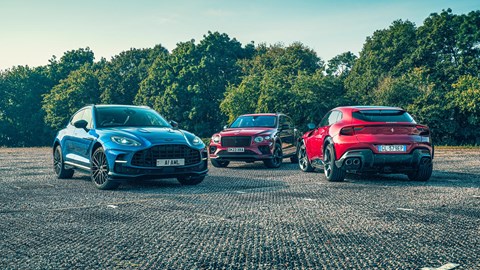
Getting to your ski resort safely, navigating a slippery slope (hill-descent control is a Ferrari first) or dipping a wheel off the road seems the extent of Ferrari’s all-terrain ambitions here, and logically so. (Ferrari does not call it an SUV, by the way, rather pitching Purosangue as ‘the first four-door, four-seat car’ in its history.)
James Dennison was suitably blown away on the press launch. Now he’s driven the Purosangue to CAR HQ, pulling up alongside me and dropping a window. ‘That’s even better than I remember,’ he enthuses. ‘Dynamically it’s astonishing… that engine is just bloody incredible.’
Thing is, SUVs tend to be about more than sparky handling and shrieky revs, so to shine a spotlight on the Ferrari’s strengths and weaknesses, we’re testing it against two SUVs from a brace of British luxury brands. Both have reinterpreted their DNA for the SUV age, and both bring unique if more by-the-book takes on off-road-ready luxury.
Aston Martin fields the DBX 707, which currently moonlights as the F1 Medical Car (a clue that it holds much more stuff than its Italian rival) and stands as the hottest version of Aston’s first SUV.
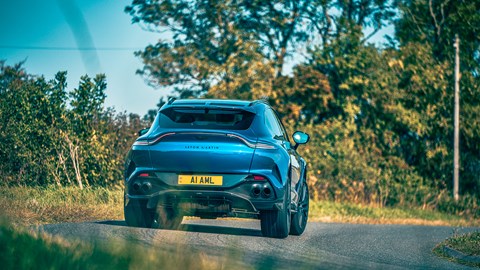
Like the Ferrari (but not the Bentley), the Aston gets clean-sheet underpinnings, with 707 upgrades including tweaked triple-volume air suspension, ceramic brakes and various exterior and interior tweaks (exterior trim like it’s wearing shades, more aggressive sports seats, etc).
Crucially, the familiar Mercedes-sourced V8 is bumped a frankly massive 154bhp to just under 700bhp or palindromic 707PS – and evokes a certain secret agent in the process.
To dip into those twin-turbocharged reserves is to feel 2.2 tonnes swept forwards like it’s riding a tidal surge down an estuary. Nine closely stacked (obvs) gears amplify the rush, as part machine gun, part heavy flatulence bombast roars from new quad exhaust pipes.
This is rampant performance, a near dead-heat with the Ferrari’s 715bhp, and a delivery that’s altogether more muscular and flexible courtesy of turbocharged torque – 663lb ft @ 4500rpm monsters the Ferrari’s 528lb ft, never mind that the Italian’s is served much higher at 6250rpm (though the Aston needs 2800rpm to get boosting).
Yet the DBX 707 starts from £194,500 to the Ferrari’s £313,120. Add options and the gulf widens to £238,860 and £411,619 respectively.
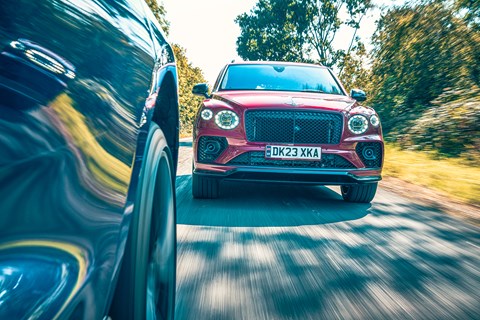
The Bentley Bentayga S closely matches the DBX 707 at £189,700, though 542bhp from its Porsche-sourced V8 falls way short. Given its 2341kg is nearly 100kg portlier than the Aston, it’s no wonder you feel the disparity behind the wheel – though 4.5sec to 62mph and 180mph all-in is ‘sufficient’, as a previous Bentley custodian might say.
Sounds great, too. With its standard sports exhaust, there’s a richly indulgent V8 bob-a-bob-a-bob like chocolate glugging in a vat, not to mention a more authentic timbre than the Aston. It seems odd, though, that it’s no punchier than the regular V8 Bentayga.
S-ness is instead communicated by revised chassis settings, that exhaust and some garnish that veers more towards Premiership training sessions than cricket-ball leather. To be fair it’s clearly aimed at a younger demographic – buy the stock V8 if you want to keep things stately.
I jump in the Aston first, settling into a sports seat that feels relatively high-set in this cabin, the perch amplified by a rakish windscreen and header rail that feels quite prominent in my vision.
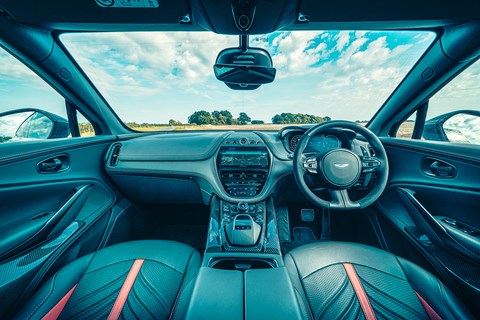
Myriad buttons are reminiscent of the batak fitness training games used by race drivers to test hand-eye co-ordination, reaction times and peripheral vision. Do a 10,000-mile stint here and you’d be sharp enough to beat the whole F1 grid off the lights.
At least drive-mode settings are intuitive to use by touch alone and the driving experience more than atones, because in its default GT setting the DBX glides gorgeously. Full air suspension and active anti-roll control take the sting out of our car’s optional low-profile rubber on 23-inch wheels, so it tracks true over heavily cambered roads, irons out ravaged outer edges of tarmac yet still feels keyed into the surface. Neat trick.
Easy low-down torque and gentle shifts from the nine-speed wet-clutch auto add to the waft, and (flaps closed) there’s an underplayed exhaust like a butler clearing his throat.
But hints of a more sporting flavour percolate all the while, notably the organic feel of the DBX’s steering. It’s nicely weighted, self-centres naturally and brings a punch to off-centre response without introducing an unwanted edge. Even if you’re barely tapping this car’s frankly huge dynamic capabilities, it helps shrink five metres plus and all that mass.
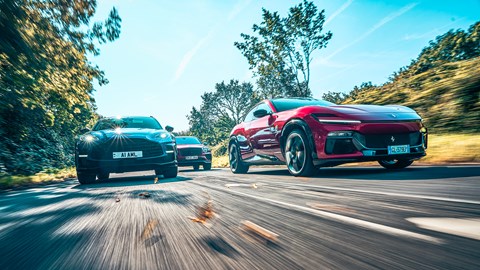
Select Sport and suspension travel tightens up without throwing compliance under the bus, and for such a big, heavy car, the 707 is surprisingly content walking the tightrope between grip and slip – it keys into the road surface pretty keenly up front and feels flamboyantly rear-biased when you dig into all that performance.
‘There’s some lean but when it settles into a corner grip levels are phenomenal,’ James confirms. ‘More than happy to oversteer too, which is terrifying and hilarious at the same time.’
Less convincing is the latency of the gearshifts, and carbon-ceramic brakes that – while ultimately highly effective – suffer from an excessively long pedal in this example. Both knock precision from the drive.
But our main beef lies with the DBX’s interior and infotainment. It’s pleasant enough inside (the panoramic roof brings a gorgeous clarity for rear-seat passengers), and it’s certainly comfortable (seat bases could be plusher, mind), but the design feels a little plain, those buttons are all over the shop and the infotainment is way off the pace. ‘A five-year-old A-Class has an infotainment upgrade over this – which, for £200k, is shocking,’ comments Dennison.
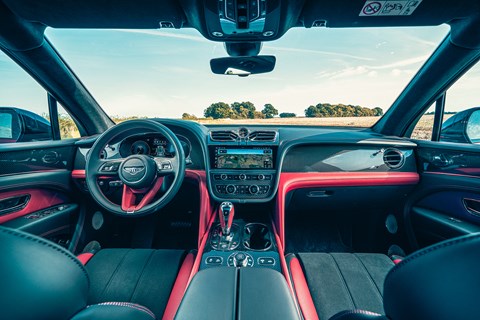
The Bentley’s interior more appropriately matches the price point. The seating position actually feels lower than the Aston (the Bentley’s roofline is 6cm loftier), the seats better accommodate more generous frames, and the cushioning has a lovely elastic squish. I’d need to be horizontal to get more comfortable.
Controls are logically arranged, and the infotainment – while clearly dated – is best on test. ‘The cabin is wonderful,’ comments James. ‘I know a lot of parts are rehashed from Audi, but they work brilliantly and it still feels a million dollars. The click from the climate control dials is very deliberate, plus there’s a different sound for each dial. I also like how the opulence continues into the back seats.’
The Bentayga drives with a markedly different set of priorities to the Aston. The steering is isolated to the point of numbness and takes so long to wake up that my first thought is defibrillator, not 10º more lock. It’s great for stability and filtering out bumps, not so good for meaningful dialogue with the front tyres.

Like the Aston, the Bentley also rides on air suspension with active anti-roll control, but it’s off-the-charts for cush, sighing into compressions like it’s dropping into a favourite armchair. Talk about dreamy.
Only the Sport chassis mode is altered over standard, bringing 15 per cent firmer settings, and even then I’m pretty sure it’s still more compliant than the Aston’s GT mode.
The powertrain perfectly suits this relaxed character – smooth and energetic on-demand rather than fizzy and abrupt straight off the bat, with glossy gearshifts and linear power delivery to match.
Only an errant hovercraft could explore Cambridgeshire more imperiously than this, and there’s more pace than you expect given such cotton-wool pampering. What the Bentayga lacks is dynamism.
To be fair, the Bentley remains unruffled despite physics’ best efforts, even up to eight-tenths or so, but it unravels beyond that, even if it is more don’t-drag-me-onto-the-dancefloor lethargy than true waywardness.
What nags is that Bentley hasn’t dialled up the performance or handling more, given the standard V8 remains on sale – 580bhp or so and a sharper chassis would better complement the louder design and still leave breathing space for the range-topping W12 Speed.
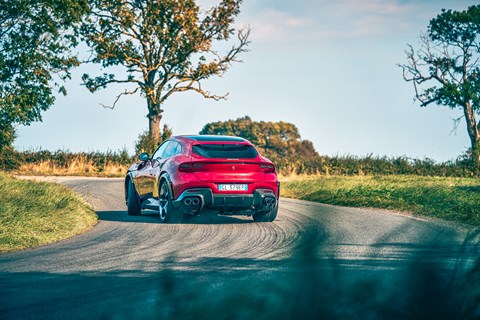
The Ferrari is a bolt of lightning in comparison. From the visual pop of an exterior design fusing Daytona SP3 and GTC4 Lusso with RoboCop to its witchcraft dynamics, the Purosangue feels closer to a supercar.
Inside, it’s a similarly un-SUV-like experience. You naturally sit much lower, unable to see the car’s extremities because the front-mid engine allows the bonnet to slip away so slinkily (it does feel excessively wide on tighter B-roads). The sports seats grip you securely, and everything from the small-diameter steering wheel of many buttons to the central yellow revcounter mentally primes you for a Ferrari driving experience.
I’ll be writing a hybrid crossover group test next if I’m not careful here, but I have to say the Ferrari – yes, the 715bhp, 3.3sec to 62mph, over 194mph flat-out Ferrari – isn’t as rapid as expected. Two things are going on: first, the V12 lacks the other cars’ turbo muscle; and second, last time I tried this engine it was dropped in an 812 Competizione, a much lighter and more powerful machine with such feral response your brain screams ‘eject!’ each time you prod the throttle.
So the Purosangue weighs more, and the V12 is both mapped for less knee-jerky reaction times and significantly re-engineered for this application. But the truth is it’s still a riotously rapid and responsive machine.
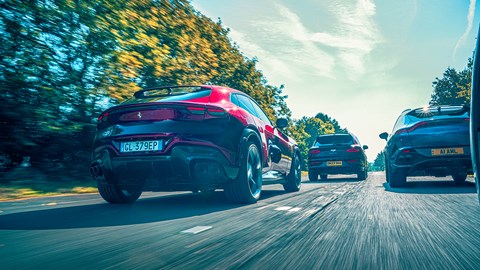
Dig into its performance and it has the linearity of a rocket launch and the frenzied noise of a philharmonic finale as it climbs and climbs. Beyond 5000rpm speed and sound dominates everything, then you click a long carbonfibre paddleshifter at the 7750rpm power peak – 8250rpm if you fancy – and another gear ratio snaps in synaptically.
Best powertrain on test, easy.
Despite its clear focus on dynamic engagement and use of coil springs all-round, the Purosangue also rides sensationally. Multimatic active dampers are key, and no question they offer appropriate comfort and refinement for this segment. But crank it up and, oh my…
There is, to be fair, a lot going on with this chassis, particularly the fact it’s all-wheel drive, has those fiendishly clever active dampers and boasts four-wheel steering that can adjust the angle of the rear wheels independently. Start to hustle in the softer of three settings and the waspish steering, instant brake pedal and aggressive front-end bite all feel a little at odds with more lean than we’re accustomed to in modern Ferraris. The chassis also carves on something of a knife-edge and isn’t entirely natural or transparent – it pre-emptively tucks into corners more aggressively than expected, especially given today’s context.
Incredible/ridiculous as it sounds, though, this is a super-sports SUV that thrives on tyre temperature. Get its Michelins switched on, ramp up the suspension to ‘medium’ and what initially felt like a slightly unforgiving and laser-like pinpoint seems to refract through a prism.

Hesitant, finger-tippy inputs make way for larger, more confident sweeps at the wheel and pedal presses, as the startling response is matched by reassuringly smeary stickiness. The way you can launch the Ferrari into a corner then almost immediately climb onto the throttle is borderline surreal for any car, never mind something wearing turn-ups.
‘You can appreciate the weight, but it’s so incredibly well handled and at road speeds it feels like the chassis always has the measure of the mass,’ notes Dennison. ‘Front-end turn-in is very pointy, the four-wheel steer gives excellent artificial rotation, while rear-biased four-wheel drive means four-wheel drifts and natural rotation on corner exit.’
Newsflash: two motoring journalists love driving a new Ferrari at the limit then handing it back… But clearly this new breed of Fezza must offer a broader repertoire. Think in those terms and a few chinks appear in its armour, not least mpg… We reduce it to single figures, while the others clock 12-13mpg, though we do drive the Ferrari harder.

The cabin – though sportily focused and smart – lacks visual interest in some rather stark areas, a feeling no doubt amplified by this car’s funereal trim. Much worse, laggy touch-sensitive inputs on the steering wheel control infotainment screens positioned behind it. At least your passenger has a screen dead-ahead to help out with some functions. What you don’t have anywhere is sat-nav, so make sure you have a generous data plan for those road trips in your £300k SUV.
Rear doors hinge outwards like a Mazda RX-8. Sometimes their electrical assistance worked, but it often didn’t if the ignition was off, and the protruding bits at the bottom thrice took me out at the ankles.
There’s less space in the back of the Ferrari, too, and only two rear seats in the second row where the others have three. But 6ft adults can sit comfortably behind each other, even if the headlining gets a little familiar with your hairdo. Boot space is officially close to the Bentley’s, though it looks much less. Not perfect, then, but there’s no question Ferrari has created something special here.
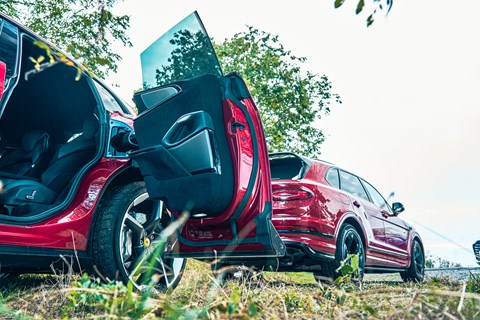
Verdict
When three rivals target such different priorities as the Bentayga, Purosangue and DBX 707, calling a fair verdict involves much hand-wringing and can be resolved only with a higher-than-average degree of subjectivity.
With that caveat in mind, the Aston Martin is the SUV I’d buy. It has the greatest bandwidth of the test, offering comfort, refinement, handling and performance to impress whether you’ve dialled it back or have everything cranked up to 11.
Crucially, there’s ample practicality for five, a price that massively undercuts the Ferrari and more than enough off-road ability for most of us. Just remember our must-do-betters for the infotainment and interior generally, but the Aston is a very good car.
That said, it seems wrong-headed to rank the Aston above the Ferrari given the latter’s excellence in terms of dynamics, powertrain and design, hence this Giant Test’s joint first place. The Purosangue is a much more extreme kind of car.
Its coupe-shooting brake design is far sexier than its rivals, the naturally-aspirated V12 and dual-clutch gearbox have extraordinary feist and response, and the chassis fuses surefooted grip with engagement the others just can’t match.
Active dampers mean the Ferrari even rides beautifully too and – though more compact at 4973mm long – it can accommodate four adults with a reasonable amount of luggage. Approached as a luxury GT that drives like a big supercar, it’s a five-star winner. But judge it for outright practicality, ground clearance, value and infotainment (yes, even the Aston is better, and at least it has sat-nav), the Ferrari plays second fiddle to both rivals. Only you will know if that’s a fit for your needs or not.
Ranking the Bentley last doesn’t sit well, not least because it scores best for comfort, luxury, interior quality and for having the most intuitive infotainment system on test. If I wanted the family to feel as relaxed as possible come journey’s end, this is the car I’d take. But I do find it a little half-baked as an S -– improved performance and handling would make a stronger impression without detracting from the all-round appeal.
Then James Dennison really stress-tests my last-place logic. ‘If you’ve got this much money to spend you can probably afford a proper supercar as well,’ he argues. ‘So rather than have an SUV that tries to be a supercar, why not have an actual supercar and a very comfy SUV that’s fast in a straight line? That’s what the Bentley does.’
He’s bang on as ever, and maybe you’ve just had an epiphany to buy the Bentayga and a 296 GTB. But if there’s only space in my garage for one and the cost-of-living crisis is biting… I’ll take that Aston to do it all, thanks very much.
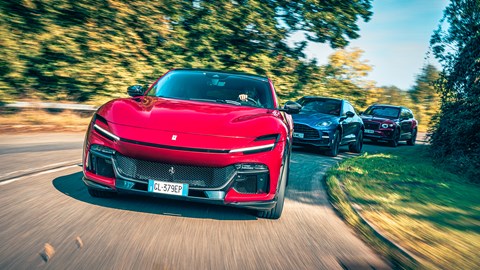
The final reckoning
1st= Aston Martin DBX 707 ★★★★★
Bridges the chasm between the Ferrari’s dynamism and the Bentley’s luxurious versatility. But a DIY SOS for the interior, particularly its infotainment
1st= Ferrari Purosangue ★★★★★
Most extreme, best to drive and still with GT credentials. Less versatile than others, poor infotainment
3rd Bentley Bentayga S ★★★★★
Best for comfort, luxury and interior. Dynamics and performance under-deliver here